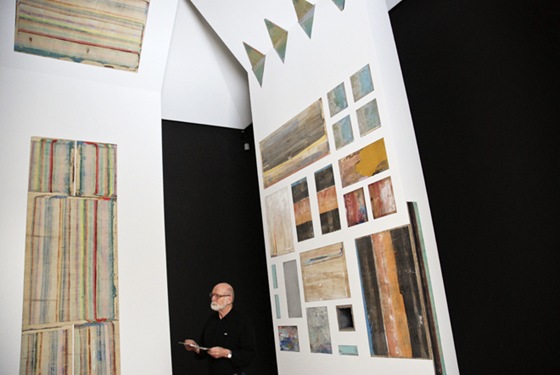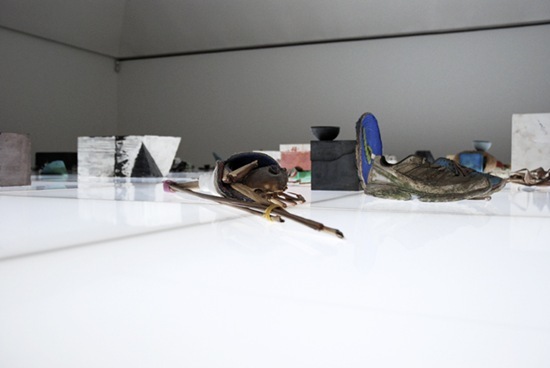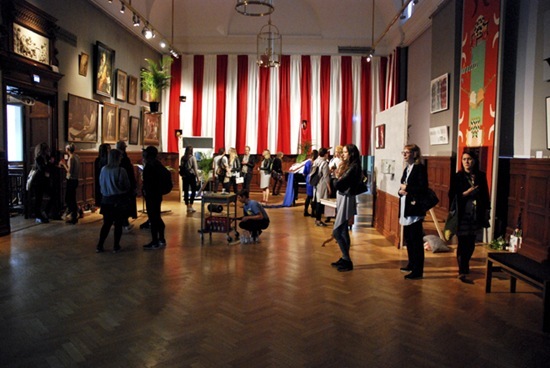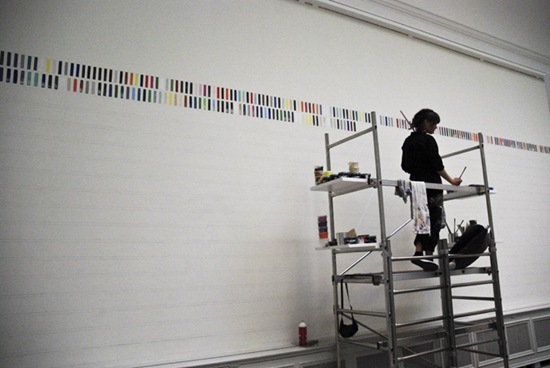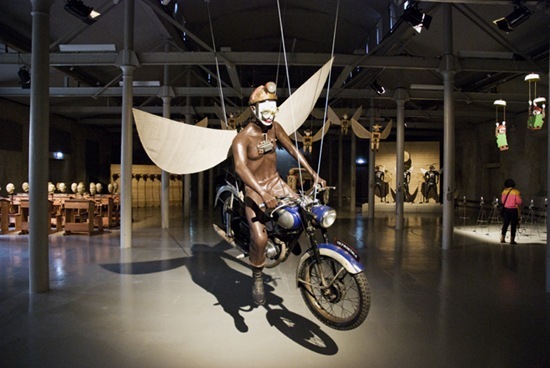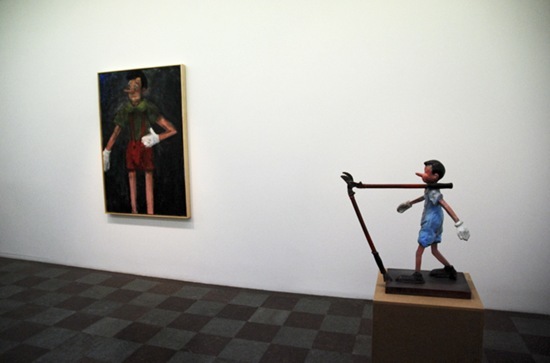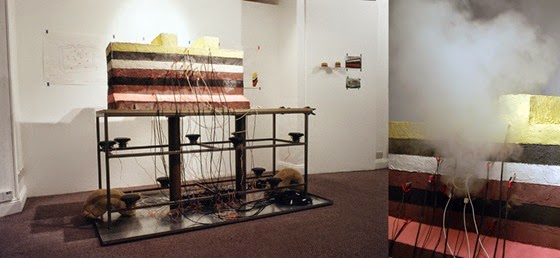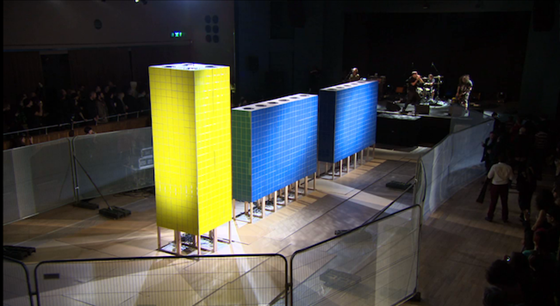 © Benjamin Bratton – from his website & attributed to The Black Stack section
© Benjamin Bratton – from his website & attributed to The Black Stack section
In relation to the digital network or Stack, Benjamin Bratton observes that the ‘plural User subject’, who is ‘conjoined by a proxy link or other means’ and ‘could be composed of different types of addressable subjects: two humans in different countries, or a human and a sensor, a sensor and a bot, a human and a robot and a sensor, a whatever and a whatever’[1] – therefore how does the artist operate within the type of inexhaustible network of connections and sensory inputs that Bratton describes here? As he asserts, it is conceivable that in an online exchange, any of the correspondents involved might not be human, even if posing as such. The wide-spread introduction of Captcha (software developed in order to identify non-human sensors, generally inputting spam) is testament to this relatively recent online trend. This is a situation indicative of what is, and will continue to become more common and less questioned all the time. Therefore, in this sense the human user also becomes a type of sophisticated sensory constituent, in a vast open interconnected multi-directional system. The artist and their relationship with the Internet, allows them the potential to become an active sensor par excellence. I consider that today’s artist – those vigorously engaged with the communicatory digital sphere – generally function in three fundamental ways. One, consuming vast amounts of information; secondly, (in)directly ‘creating’ from this material and knowledge; and lastly, distributing these creations and communicatory data, back into the ‘network’. By way of a connection here, Vilém Flusser writes in 1989: ‘Owing to the manner in which images are currently transported, they must serve the same function as’, ‘codes of conduct’. ‘They must transform their addressees into objects. This is the intention of portability.’ (…) ‘In our contemporary society, the new media are currently geared toward making images into models of behaviour and people into objects.’[2] His descriptions in this text could be describing what we have come to know as the World Wide Web, two years before it was properly developed. Crucially in this context though, his idea of ‘people as objects’, relates to my suggestion of the human as, with and occupying the position of a type of complex inhuman computational sensor. The artist’s role here, within the contemporary Post-Internet environment, continues to become a most active, committed, adaptive and multi-faceted, participatory one.
Art is a visionary engagement that exceeds and extends beyond quantification.[3]
The assumption that Capitalism needs to subsume everything in order to continually reproduce itself and in the process, create the general artist - one that is able to exceed capitalist subsumption through an abstraction of capital and by negating use value and creating their own self-valorisation[4] - is worth considering in relation to Post-Internet and the artist. As Brad Troemel points out, ‘Modes of production employed by artists are often a reflection of the larger cultural Zeitgeist.’ (…) ‘And for the generation of artists coming of age today, it is the high-volume, fast-paced endeavour of social media's attention economy that mimics the digital economy of stock trading, a market increasingly dominated by computer-automated algorithmic trades. For these artists, art is no longer merely traded like ‘stock’; it's created like one, too.’ [5] Presently, the artist uses the Internet as a primary source material for their work. Regardless of the form the work takes or materials used; often these are acquired through, and then from Internet sources. This constant form of mediation has now become subliminal and isn’t even a consideration for most - hence this is when the Internet becomes ‘Post’. Comparable to ‘stock’ in Troemel’s description, this continuous stream of data extractions & then insertions by the artist, is steadily becoming the standard means in which they research, develop, reflect, interpret their experiences, and in turn, facilitate their role as an artist within capitalism’s reproductive system – a system, where ‘value’, in all its forms, is the overriding principle.
The artwork is a socially mediated commodity that transcends the standard value form, as it adheres to a different set of ideas in this regard. It is a commodity absolute, because it is aware that it is one. Therefore it can and often does reflect upon this reality, unlike other commodified objects. A claim made by Benjamin Noys when discussing ‘the realism of the Abstract’ and where art’s critical engagement with the paradox of valorisation is established. He suggests that, because of its ‘functionlessness’ and lack of any real and actual necessity, art is therefore ‘rooted in the paradox of abstract labour’.[6] But moreover, it has the capacity to embrace and communicate such ideas, where labour (deemed abstract or otherwise) never does.
The art object is the same as the image or ‘art image’ in this way: ‘All objects create another’[7], since they prompt or pre-empt a certain cognitive or even biological process, that introduces or leads to another thought, image or object. This sequential process is potentially inexhaustible. ‘The meaning of an image can be changed according to what you see beside it or what comes after it’[8]. This quote from John Berger is a simple description of a fundamental process within human cognition. And from an image or object, for the artist, many more are devised, literally and symbolically. The morphing and merging of ideas into new ones, then fed back into the system, defines the Post-Internet experience. Think of the artist working from online material today; the abundance and accessibility of which, is beyond comprehension and unparalleled. In reference to Flusser again and echoing Berger’s previous comments on images, their successions, ‘objects’ and their aftermath, he writes that, the representations in representational images, ‘form a circle, that is, one draws its meaning from the other, which in turn lends its meaning to the next.’[9] What does this mean then for the artist saturated by images and objects; making work from all manner of ‘texts’ and cultural sources? The banal, trivial and even mistakes (in the ‘Freudian slipped’ sense) make for interesting and often profound statements on class, capital, society, culture (the high, low & in-between varieties) etc. And clearly, the opposite can also be true, where this comment is concerned.
If social capital comes from the practice of taste-making (compiling images instead of making them), artists who have been called ‘post-internet artists’ can be considered alchemists. They take stock of the rubbish heap of net history. They turn shit into gold by compressing and decompressing digital artefacts, rehashing them into something informative, intellectually abstract, and visually elegant.[10]
Chan’s remarks on the artist here emphasise the hybrid nature of this method of ‘tactical web surfing’ and the ‘hyper-mediation of existing genres’ that help categorise the modes in which the artist uses the digital network. If, as Gene McHugh suggests, ‘new media’ becomes art by mutating ‘itself to become more like the art world art, the work mutates art world art to become more like the internet.’ This creates ‘work that has one foot in the history of art and another foot in the experience of network culture.’[11]
To conclude for now, if one considers the unbounded potential (constructive and otherwise) of the digitalised, tele-networked, global society we now exist in and are (pre-)determined by – there seems no rational arguments for accepting the world in any pre-determined form. I judge the practice of individualised questioning and analysing, potentially all images, objects or matters of attention, has now become standard practice. This is the way in which most artists now function. The idea that what we experience, or ‘the/our world’, was made a certain way ‘and that we should not presume to ask why it was made this way and not some other way’ is an argument that has no reasonable legitimacy anymore in my view. Consequently, as we observe in today’s heightened acts of formulation and research by artists, through mediation with the Internet, they simply are not accepting ‘the world as they find it’.[12] And are subsequently creating anew by challenging what they find.
This text was written for the IASPIS Open House, Spring 2016 (Friday, 18th of March, 2016), Stockholm. These are initial comments on specific artistic research methodologies and aims to examine certain contemporary debates around the Artist, (Post-) Internet and Capitalism. The ideas derive from interpretations on working methods perceived in particular artist’s practices.
P.
1 Bratton, Benjamin: The Black Stack (http://www.e-flux.com/journal/the-black-stack/, 2014)
2 Flusser, Vilém: Writings, ed. Andreas Ströhl (Minneapolis: University of Minnesota Press, 2002) 73-4.
3 Essoglou, Tracy Ann: Lets Talk About The Debt Do For… Responses (http://artanddebt.org/lets-talk-about-the-debt-do-for-responses/, 2015)
4 Noys, Benjamin: The Art of Capital: Artistic Identity and the Paradox of Valorisation, (https://www.youtube.com/watch?v=BGywpIgHeq0 , http://www.academia.edu/689156/The_Art_of_Capital_Artistic_Identity_and_the_Paradox_of_Valorisation, 2011)5 Troemel, Brad: Art After Social Media, ‘You Are Here - Art After the Internet’ ed. Omar Kholeif (Manchester/London: Conrner House /Space, 2014) 42.
6 Noys
7 Harman, Graham: Art & Paradox (https://www.youtube.com/watch?v=kysr2CPu96Q, 2012)
8 Berger, John: Ways of Seeing (https://www.youtube.com/watch?v=LnfB-pUm3eI&list=PL7C3ECA9027898EB2, BBC, 1972)9 Flusser, Vilém: Into the Universe of Technical Images (Minneapolis: University of Minnesota Press, 2002) 8-9.
10 Chan, Jennifer: Notes on Post-Internet, ‘You Are Here - Art After the Internet’ ed. Omar Kholeif (Manchester/London: Conrner House /Space, 2014) 110.
11 McHugh, Gene: Post Internet: notes on the Internet & Art (Brescia: Link Editions, 2011) 16.
12 Brassier, Ray: Prometheanism, ‘Accelerate: the Accelerationist Reader’ ed. Robin Mackay & Armen Avanessian (Falmouth: Urbanomic Media, 2014) 485.







